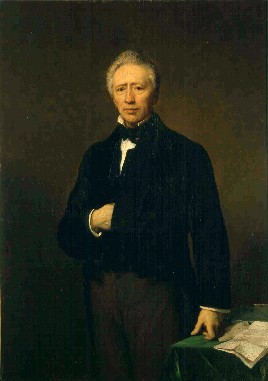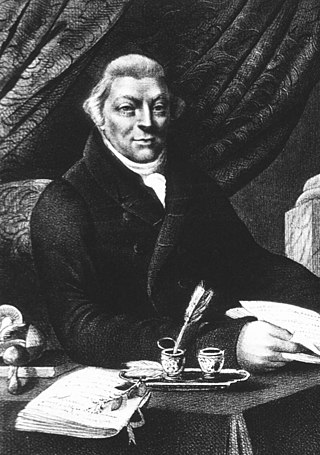
Denis Diderot was a French philosopher, art critic, and writer, best known for serving as co-founder, chief editor, and contributor to the Encyclopédie along with Jean le Rond d'Alembert. He was a prominent figure during the Age of Enlightenment.

Jean-Jacques Rousseau was a Genevan philosopher (philosophe), writer, and composer. His political philosophy influenced the progress of the Age of Enlightenment throughout Europe, as well as aspects of the French Revolution and the development of modern political, economic, and educational thought.

Jean-André Deluc or de Luc was a geologist, natural philosopher and meteorologist from the Republic of Geneva. He also devised measuring instruments.

Friedrich Melchior, Baron von Grimm was a German-born French-language journalist, art critic, diplomat and contributor to the Encyclopédie ou Dictionnaire raisonné des sciences, des arts et des métiers. In 1765 Grimm wrote Poème lyrique, an influential article for the Encyclopédie on lyric and opera librettos. Like Christoph Willibald Gluck and Ranieri de' Calzabigi, Grimm became interested in opera reform. According to Martin Fontius, a German literary theorist, "sooner or later a book entitled The Aesthetic Ideas of Grimm will have to be written."

Paul-Henri Thiry, Baron d'Holbach, known as d'Holbach, was a Franco-German philosopher, encyclopedist and writer, who was a prominent figure in the French Enlightenment. He was born Paul Heinrich Dietrich in Edesheim, near Landau in the Rhenish Palatinate, but lived and worked mainly in Paris, where he kept a salon. He helped in the dissemination of "Protestant and especially German thought", particularly in the field of the sciences, but was best known for his atheism, and for his voluminous writings against religion, the most famous of them being The System of Nature (1770) and The Universal Morality (1776).

Augustin Pyramusde Candolle was a Swiss botanist. René Louiche Desfontaines launched de Candolle's botanical career by recommending him at a herbarium. Within a couple of years de Candolle had established a new genus, and he went on to document hundreds of plant families and create a new natural plant classification system. Although de Candolle's main focus was botany, he also contributed to related fields such as phytogeography, agronomy, paleontology, medical botany, and economic botany.

Mathurin Jacques Brisson was a French zoologist and natural philosopher.

Barthélemy Charles Joseph Dumortier was a Belgian who conducted a parallel career of botanist and Member of Parliament and is the first discoverer of biological cell division.

Gabriel Bonnot de Mably, sometimes known as Abbé de Mably, was a French philosopher, historian, and writer, who for a short time served in the diplomatic corps. He was a popular 18th-century writer.

Julie or the New Heloise, originally entitled Lettres de Deux Amans, Habitans d'une petite Ville au pied des Alpes, is an epistolary novel by Jean-Jacques Rousseau, published in 1761 by Marc-Michel Rey in Amsterdam. The novel's subtitle points to the history of Héloïse d'Argenteuil and Peter Abélard, a medieval story of passion and Christian renunciation.

Thomas Martyn was an English botanist and Professor of Botany at Cambridge University. He is sometimes confused with the conchologist and entomologist of the same name. The standard author abbreviation Martyn is used to indicate this person as the author when citing a botanical name.

Jean Paulhan was a French writer, literary critic and publisher, director of the literary magazine Nouvelle Revue Française (NRF) from 1925 to 1940 and from 1946 to 1968. He was a member of the Académie française. He was born in Nîmes (Gard) and died in Paris.

Étienne Pierre Ventenat was a French botanist born in Limoges. He was the brother of naturalist Louis Ventenat (1765–1794).

Marc Antoine Louis Claret de La Tourrette was a French botanist. He corresponded with Rousseau and his official botanical abbreviation is Latourr.

Antoine-Jacques Roustan was a Genevan pastor and theologian, who engaged in an extensive correspondence with Jean-Jacques Rousseau. Unlike Rousseau, he believed that a Christian republic was practical - that the Christian religion was not incompatible with patriotism or republicanism.

Jacob Vernes was a Genevan theologian and Protestant pastor in Geneva, famous for his correspondence with Voltaire and Rousseau.

Jean-Jacques Paulet was a French mycologist.

Jean-Baptiste François Rozier was a French botanist and agronomist.
The Iroquois use a wide variety of medicinal plants, including quinine, chamomile, ipecac, and a form of penicillin.

Théorie Élémentaire de la Botanique is a book written by Swiss botanist Augustin Pyramus de Candolle, which was first published in 1813 and later re-issued in 1819 with a new edition. This book contributed to the field of botany by introducing the use of the term taxonomy and a new classification system for grouping plants together. This book placed emphasis on the study of evolutionary relationships in grouping plants together, rather than on shared morphological characteristics.



















